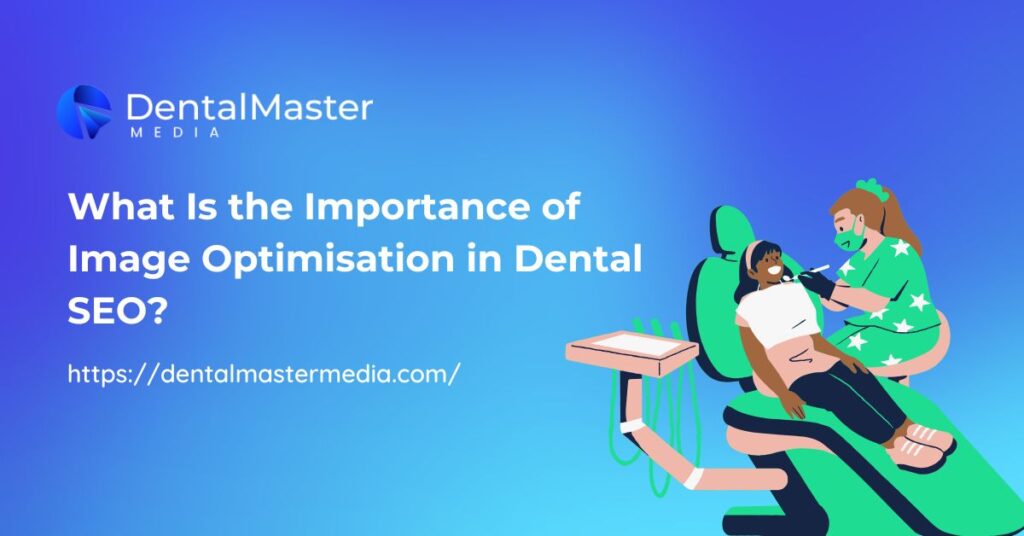Have you ever searched online for a local dentist and found your eyes drawn to the images even before reading the reviews? Whether it’s a warm welcome from a smiling team, a modern-looking dental chair, or an impressive before-and-after photo, images speak quickly and powerfully.
For many potential patients, these visuals shape their first impressions before they even read a single word on your site.
As dental practices face increasing online competition, having a visually appealing website is no longer optional—it’s essential. But good looks alone won’t help your search engine rankings.
That’s where image optimisation comes in. From faster page loads to better visibility in image search results, the way you prepare and present your images can greatly improve your dental website’s performance.
Let’s dive into why image optimisation matters so much for Dental SEO websites and how you can start using it to your advantage.
What Is Image Optimisation?
A Simple Explanation
Image optimisation is the process of preparing images so they work better on your website—both for people and search engines.
At its core, it’s about making images load quickly without looking blurry or pixelated. This is especially important for users on mobile phones or slower connections.
When images are too large or take too long to load, visitors get frustrated and may leave before your page even finishes displaying.
Faster image loading improves the performance of your site overall, leading to a better user experience.
This is something Google actively rewards with better rankings. But speed is just one part of image optimisation. Dental Industry SEO Specialists also focus on elements like alt text, file names, and image structure to make visuals work harder for your SEO goals.
Why It’s More Than Just Resizing
Image optimisation also includes using meaningful file names, adding alt text (which is a short description of the image), and selecting the right file format. These elements help search engines understand what your image is about.
For example, a file named “IMG_1234.jpg” doesn’t tell Google anything. But a file named “child-braces-treatment.jpg” paired with descriptive alt text such as “child receiving braces at a dental clinic” helps the search engine connect the image with relevant search queries. This can give your dental practice an edge in appearing in the right search results.
Why Images Matter in Dental SEO
First Impressions Count
Dentistry is a visual industry. Whether it’s showcasing cosmetic improvements or building trust with photos of your clean, welcoming clinic, images play a key role.
High-quality, original photos—especially of smile transformations—build confidence with potential patients.
Imagine someone comparing two dental websites. One features real photos of happy patients, smiling staff, and clean treatment rooms.
The other uses generic stock photos. Which site would you trust more? Most people choose the one that feels authentic, and that authenticity often comes through images first.
Keeping Visitors on the Page Longer
When people land on a dental website and see engaging visuals, they tend to stay longer. Photos help break up large blocks of text and make information easier to understand.
They also guide the reader through the content in a natural, inviting way.
This extended engagement can improve your website’s “bounce rate”—a measurement of how quickly people leave your site.
The longer someone stays, the more likely they are to take action, such as booking an appointment.
Search engines like Google notice when visitors stay longer, and they may reward your site with better rankings.
SEO Benefits of Optimised Images
Boosting Page Load Speed
A fast-loading website is more likely to rank well on search engines. Google considers page speed a ranking factor, especially with its mobile-first indexing approach.
That means your mobile site performance directly affects your visibility in search results.
Large, uncompressed images can slow down your site significantly. By reducing file size through compression and choosing the right format, you make your site faster without losing image quality. This creates a better experience for users and search engines alike.
Helping Google Understand Your Content
Google can’t “see” your images the way humans can—it relies on clues like file names and alt text to figure out what an image shows.
Adding this information gives your content a better chance of being correctly indexed and ranked.
Let’s say you have a page on teeth whitening. Including a file named “teeth-whitening-results.jpg” with the alt text “before and after teeth whitening treatment” helps Google connect that image with relevant search queries. This small step can lead to big gains in visibility.
Showing Up in Google Images
Many people use Google Images to find information visually, especially when it comes to healthcare and cosmetic services.
Patients searching for “Invisalign results” or “veneers before and after” may find images that lead them directly to your site.
When your images are properly optimised, they have a better chance of appearing in these image search results, providing an additional source of free traffic and visibility.
Common Image Mistakes Dentists Make
Uploading Large File Sizes
Photos taken on smartphones or professional cameras are often very large. Uploading them directly to your site without compressing them slows everything down.
Visitors may abandon your page before it even loads. Always compress your images before uploading them to ensure they display quickly and don’t drag down your site speed.
Using Stock Photos Everywhere
Stock images might be easy to use, but they don’t connect with patients the same way real photos do. People can tell when images are generic.
They want to see the actual team they’ll be visiting, the actual space they’ll walk into, and the real results they can expect.
Original photos help create trust, and trust leads to more bookings. From a search perspective, original content also performs better than widely used stock imagery.
Skipping Alt Text
Alt text is often overlooked, but it’s essential. Not only does it help visually impaired users navigate your site, but it also gives search engines valuable information about your content.
Leaving it blank means missing out on a simple but effective Seo For Dentist opportunity. Descriptive, keyword-relevant alt text strengthens your site’s relevance and accessibility.

How to Optimise Images for Dental Websites
Use Descriptive File Names
File names should describe what’s in the image. Instead of using default names like “IMG_2023.jpg,” rename the file to something like “before-after-braces-treatment.jpg.” This helps search engines understand the image content and improves its visibility.
Compress Without Losing Quality
Use free tools like TinyPNG, Squoosh, or ImageOptim to reduce image size while keeping them crisp. Compressed images help your pages load faster, improving both SEO and user experience.
Add Alt Text That Describes the Image Clearly
Every image should have a short description that tells what it shows. Keep it simple but informative. For example, “teen patient wearing clear aligners” or “before and after dental implant procedure.”
This helps users who rely on screen readers, and it gives Google helpful context for indexing the image correctly.
Choose the Right Format
Use JPEG for photos, PNG for images with text or logos, and WebP for a good balance between quality and speed.
Each format has a specific use, and choosing the right one contributes to faster loading and better performance.
How Image Optimisation Fits into Overall SEO For Dentist Websites
Builds Trust and Clicks
High-quality, fast-loading images create a positive user experience. When people see appealing visuals that load quickly, they’re more likely to stay, click through other pages, and eventually book an appointment. These interactions signal value to Google, which may improve your rankings.
Improves Local Search Rankings
Google’s local search algorithm pays attention to engagement and quality. Clinics with high-quality, optimised images often appear more attractive in the local map pack, especially on mobile devices. This means more exposure and more chances to be chosen over competitors.
Connects with Other Optimisation Efforts
Image optimisation supports other aspects of SEO, such as content quality, mobile experience, and page speed.
It complements written content and enhances visual storytelling—especially important for a service as personal and appearance-focused as dentistry.
At Dental Master Media, we’ve seen the difference that well-optimised images can make. Whether you’re refreshing your gallery or building a new landing page, image improvements are a smart, efficient way to boost your site’s performance.
Why Dentists Should Care About This Now
Patients Are Judging You Before They Call
Today, your website is your digital front door. Many patients will judge your professionalism, cleanliness, and results based on your images alone.
If your photos are slow to load, unclear, or obviously stock images, you risk losing that trust before a call is even made.
Competitive Advantage
The truth is, many dental SEO clinics haven’t taken full advantage of image optimisation. That’s why doing it well can give you an edge.
With just a few tweaks, your site can look better, load faster, and perform higher in search—giving you a leg up in a competitive space.
Conclusion
Image optimisation might seem minor, but it can have a big impact on your dental website’s performance.
From faster loading pages to improved rankings and better user experience, optimised images help attract and keep potential patients on your site.
The good news is, you don’t need advanced tools or technical skills to get started. Simply compress one large image, give it a clear file name, and add a short alt text.
Small changes like these can make a noticeable difference over time.
If you’d like expert help with improving your site’s visuals and performance, the team at Dental Master Media is ready to support you.

Suraj Rana is the owner of Dental Master Media and a leading expert in SEO for dental practices. With a passion for dental marketing, he has successfully helped numerous dental clinics climb the search engine ranks. Suraj’s expertise makes him a go-to resource for effective, results-driven dental marketing.

